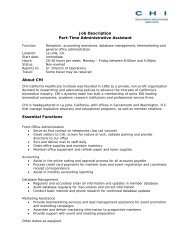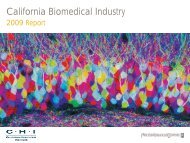California Biomedical Industry - California Healthcare Institute
California Biomedical Industry - California Healthcare Institute
California Biomedical Industry - California Healthcare Institute
Create successful ePaper yourself
Turn your PDF publications into a flip-book with our unique Google optimized e-Paper software.
“Only by lowering the barriers to entryinto this important field, can we attractthe very best scientists, ethicists,students, physicians, and fellows tostem cell research,” Goldstein said.At the same time, Goldstein is workingon a research project team with aphysician scientist who moved fromprivate practice to research by wayof a CIRM New Faculty grant. “She isworking at the very nexus of science andclinical practice,” Goldstein said, whichis where she wants to be. Further, hercontributions and insights already areproving invaluable to the team’s work.Third among CIRM’s catalyst roles,Goldstein said, was the formationand issuance of Disease TeamResearch Awards. Established to fundmultidisciplinary teams, these grantsenable teams to conduct the researchand regulatory activities necessaryto prepare and file a complete, wellsupported investigational new drugapplication (IND) with FDA.Goldstein is co-principal investigator ona Disease Team Award aimed at treatingamyotrophic lateral sclerosis (ALS)(see sidebar). He said that the teamsubmitted their idea when it really wasjust an idea. On the wall of his office atUCSD is a Gantt chart that illustratesevery key task to move that idea to theIND delivery date, four years from theproject’s start.“We’re working within incrediblyaggressive timelines,” Goldsteinadmits. “But sometimes things areas slow as you allow them to be.”There is no allowance for slow on theDisease Team projects: should theteam miss a milestone, or run into aninsurmountable research problem, thegrant ends and the remaining fundsrevert to CIRM. If the project succeedsand results in a commercializedtherapy, the grant converts to a loan, tobe paid back to CIRM through royalties.Either outcome ensures some fundingas well as invaluable data for futureresearch programs.The grant’s requirements ensurethat the teams have the businessand management tools they need tosucceed. For instance, CIRM insiststhat the Disease Team Award recipientshire experienced project managers.Goldstein said his team secured onewho insisted that they start talkingto the FDA as early as possible.Considering the agency’s needs andconcerns in the earliest stages of theresearch planning both guides the teamin addressing real-world considerationsand informs the FDA on issues to beprepared for as the programs reachfruition.The interactions have been sovaluable, Goldstein said, that he hasencouraged CIRM to work with thetop administrators at the FDA, toshare collective experiences and beginassembling the regulatory frameworkfor stem cell-related products.The final way that CIRM is ensuringthe commercial future of stem cellbreakthroughs, Goldstein said, isputting researchers and companiestogether on the same teams. Although“that piece is just getting started,”he said, it is a vital component to theemerging sector’s success.“Just getting started” is how Goldsteinalso describes the current state of stemcell research as a field. “There is nocomparison between the early daysand now,” he said, “and we’ve onlyscratched the surface.”The said the technology has becomevery powerful. It will need to be toenable scientists to reach their goal:“To take stem cells and command themto become something and producethem in quantity and at quality toallow for the safe and efficacious use bypatients.”He said the researchers are “gettingcloser” to meeting that goal. Goldstein’sresearch is focused on understandingthe molecular mechanisms ofmovement inside brain cells and howfailures in the movement systems maylead to neurodegenerative diseases. Hislaboratory has discovered importantlinks between transport processesand diseases such as Alzheimer’s andHuntington’s diseases. Given his focus,he may be biased when he says, “Thebrain is really where you see enormousprogress and potential for stem celltechnologies.”Yet given the list of neurologicaldisorders covered by the brain —Alzheimer’s disease ALS, Parkinson’sdisease, Huntington’s disease, lupus,multiple sclerosis, muscular dystrophy,myasthenia, autism, chronic pain,dyslexia, traumatic brain injury, and somany more — one hopes Goldstein iscorrect.Beyond the difficulties inherent infiguring out human biology and waysto use human stem cells to correctmedical problems, Goldstein sees somechallenges yet to be addressed. Yet theone that concerns him most is funding.“It’s always about the money supply,”he said. “As a nation, we woefullyunder-invest in scientific research. Wespend far more on things of far lessconsequence to ourselves. We spendmore on cigarettes as a nation than wespend on scientific research.”For this moment in time, however,<strong>California</strong> is demonstrating all thatcan be accomplished when expertise,passion, curiosity and, yes, cash, areleveraged to solve scientific puzzles.<strong>California</strong> <strong>Biomedical</strong> <strong>Industry</strong> 2011 Report | 95






